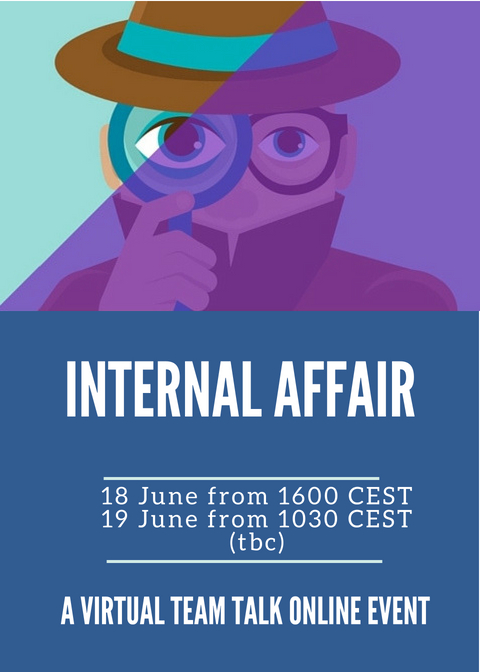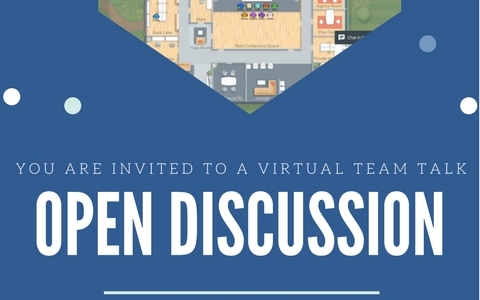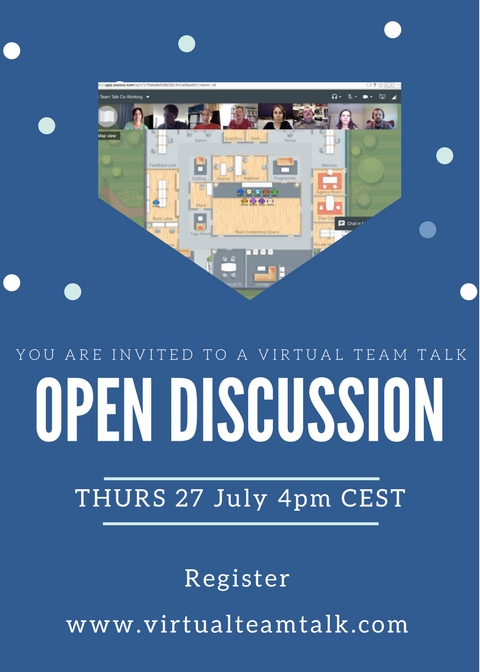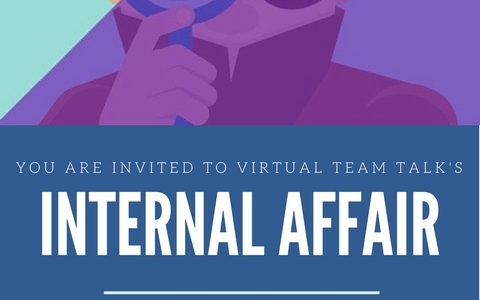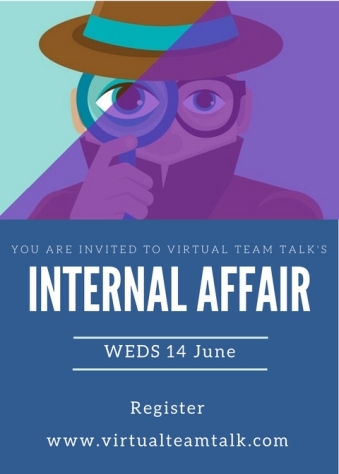Virtual Team Talk is a community of people who know that great things can happen through working with others in a different physical space to you. We’d like to share with you one of the projects we’re currently working on.
One of the most common concerns that people have when first working in a virtual team, or when thinking about working in a distributed way, is the effect that not being collocated will have on trust amongst team members.
“How will we trust each other, if we work from different locations? How will we build trust with newcomers into our team?”
These worries are not unfounded. We are gradually finding that problems that go unnoticed in the collocated world often become amplified in the virtual sphere, such as aggressive cultures, lack of alignment in teams and lack of trust.
Whereas in the collocated space you might coast along in spite of the absence of real trust between teammates, in the virtual space, it will impact your work. And trust can indeed be built as a virtual team: Trust is built through your actions, not your physical presence.
Is Trust Important?
There are many simple practices that virtual teams share to build trust: in-person get-togethers, sharing personal stories, having virtual coffee or even virtual popcorn regularly… but what does “trust” really look like in a team? Why is it important to make sure we build trust? What can we do to ensure (and even accelerate) its development?
And why should we bother? Is it just that it makes us feel closer together as a team? (And that would be enough from my point of view to work on it.) Or does it also help with our productivity and performance?
These are some of the questions we’re currently tackling in Virtual Team Talk. Yesterday, four of us met to talk through these questions and share the processes and practices we need when working in virtual teams. We’ve gone quite “meta” (like Melanie P., also from VTT would say) so we don’t have ten simple tips to share with you. However, below, we have pinpointed three areas of the team process worth revisiting if you’re worried about trust being eroded in your team.
The Role of the Individual
Before we dive into how trust can be built amongst people, it’s worth remembering that regardless of how we operate as a team, our propensity to trust as individuals will vary. Some of us (like me!) are quick to trust others. And there will be other people who will be on the look out for untrustworthy behaviour for months after they start working with a team.
This is quite important in all teamwork, but in distributed work the propensity to trust is key. Unless we start to trust each other soon, even before we meet face to face, our work will be sluggish and maybe not that enjoyable. As soon as we start to trust each other, we reach out for help faster, we share our problems more often and we might even be happier at work. The individual’s natural tendency to trust others will play a part in all this.
We discussed whether there is anything that can be done during the hiring process to assess someone’s propensity to trust. The only conclusion we came up with was to think of the hiring process beyond the initial interviews and into a three month “trial period”, during which a person’s trusting behaviours are also monitored, not just their skills.
(We might well come back to this in detail, as Mel had something to add post-meeting on how to use the VIST model (Hertel, 2002) during recruitment.)
Team Process
Ideally, our team process, our communication habits and even how we design our tasks will have elements that help us to build trust. Here are three areas worth addressing when revisiting how you operate as a team.
(A) What’s Your Purpose?
Regardless of the differences existing in your team, you will all have a shared purpose. It might a broad, top-level organisational purpose; or the purpose of your activities might change with each project.
In any case, having this top of mind can help nurture trusting and trustworthy behaviours. For example, if I know what the wide purpose of my team is, I can continuously search for areas of improvement where I can add value, rather than worrying about protecting my own work.
There’s a fine line between remembering our purpose for working together and being constantly reminded of it through visuals and top-down communication. You might need to be creative in how you embed purpose in your team. An interesting practice shared by Terrance during our conversation was placing an empty chair (a real one if in person or an imaginary one if virtual) at the end of the meeting for the “customer” to sit in. (For more on this, check out https://goo.gl/lfq7mA )
The role of the customer could be taken up by anyone in the team. They would probe team members and answer questions themselves about their needs. This brought about an immediate shift in perspective not just for the person in the chair, but for the whole team.
The team purpose becomes clear: helping the customer.
In this scenario, team members are not just drawn together into discussion around a common purpose, but they also get to probe and understand the problem together. This common experience makes their own thought processes visible, and so helps to build trust. It also reminds us of the value of feeling empathy for those around us – whether our customers, our team members or other people in the organisation. Being able to step into someone else’s shoes helps us to understand them better and this, in turn, can make our own behaviour more trustworthy.
The exercise described here is specific to teams building products, but there will be similar exercises your team can come up with. Whatever you end up trying out, the challenge will be to incorporate it into your team’s workflow.
“Trust helps us get better results in less time.”
(B) Making the Space for Difficult Conversations to Emerge
One of the characteristics of trusting relationships is that people are able to have difficult conversations. In virtual teams, this might require extra effort, as a real time conversation needs to be planned for – as opposed to finding a moment near the coffee machine to have a five minute chat. Asynchronous communication might not be an attractive option to raise small issues, as these might gain extra weight if they are written down.
It therefore becomes even more important in the virtual/distributed space to ring-fence time for team issues to be discussed, for problems to be raised and to find ways of facilitating spontaneous conversations when they’re needed.
(If you don’t want to have to plan for spontaneity, there are tools out there through which you can easily signal your presence, to enable spontaneous conversations to emerge. You will still need some sort of guidelines within your team to be able to use them.)
Depending on the rhythm of the team and the time team members can find to meet in real time together, sharing doubts, concerns and successes (everything we mention under “Transparency”, below) might not always be that easy. Deliberately creating the space is therefore crucial. How you do this will depend on your team, so look out for those times when your team is in a sharing mood.
If the most candid conversations happen in real-time meetings, consider having some “buffer time” at the end of your meetings, where you can continue the conversation – but only if requested, don’t let it become part of your regular slot. Or you could all agree to “hang around” fifteen minutes after the meeting has ended, in case people want to pursue a conversation privately.
If your team members like to communicate asynchronously, or they just can’t get together often due to time zone or other differences in schedule, provide a space for this to happen. Have a channel or a group for “emerging conversations” or dedicate a space for people to answer “Is there something we’re not saying that needs to be said?”
(C) Transparency
Sorry, another word as difficult to pin down as trust.
So what do we mean by that?
Being transparent is making information available to others and this information might be of many kinds:
– Technical information / financial information or information about “things”.
– What people are working on.
– When you are having a hard time at work or in your personal life.
– What blocks you’re encountering.
– When you’ve made a breakthrough.
– When you’ve had success.
Being transparent includes being vulnerable and we might not always be prepared for this. However, “you can’t create trust out of thin air” and sometimes you’ll have to make yourself vulnerable first to lead by example and there are degrees of vulnerability, it’s not an all or nothing.
“Identification based trust”, where we trust people to act in our interest, emerges when we accept and understand someone’s wants and desires. This understanding is not going to happen as if by magic, so we need to make sure we make the space for it. I can’t accept and understand your wants and desires if I don’t know what they are.
In virtual teamwork, we can’t be afraid of formalizing the informal, so if we can’t design a process to understand each other better through our tasks, we’ll need to find ways of bringing us closer together parallel to our tasks.
This is often done through sharing personal information about our environment, our moods and even our meals. How we get to know each other will vary from team to team – in some teams, where tasks are ongoing and processes rarely change or are revised, discovering a person at the personal level might help us to feel safer with them. In other teams, where we continuously change our processes as we try to innovate, we might really get to know someone through their work style and how their values are reflected in the decisions they make.
Key to having a culture of transparency is knowing that whatever you share will not come to bite you back. This has been one of the many concerns of organisations becoming more transparent, but it can also happen at an individual level. Sharing that we’ve made a mistake is difficult enough. But sharing a mistake we’ve made and then having to deal with people reminding us about it three months down the line will completely quash any desire to share any future obstacles or concerns.
However you decide to continue building trust in your team, know that it won’t just be a long-term process, but one that will never end.
(This blog post reflects the current conversation a group of us at Virtual Team Talk are having around the topic of Trust. We’re communicating through text asynchronously, meeting on video synchronously and sharing resources. If you’d like to join the conversation, let us know.)
